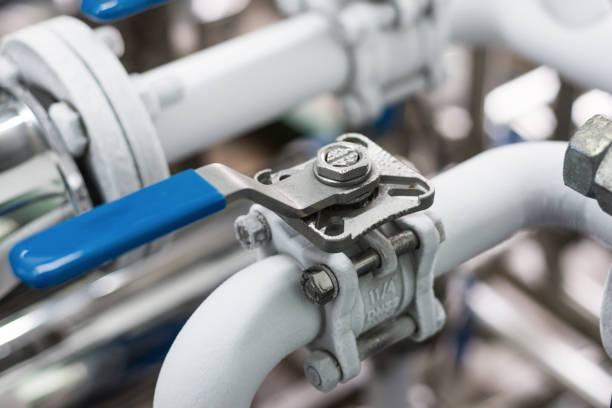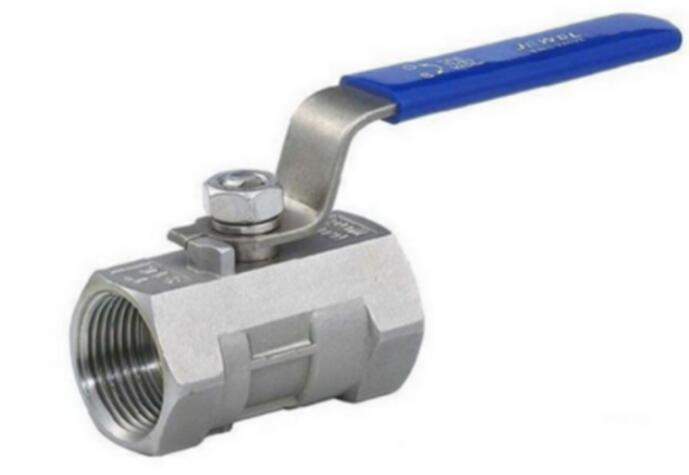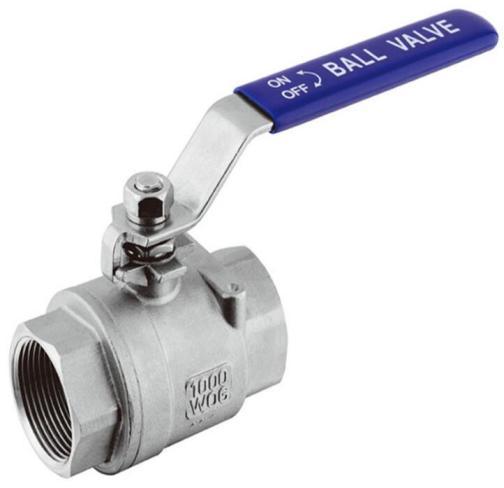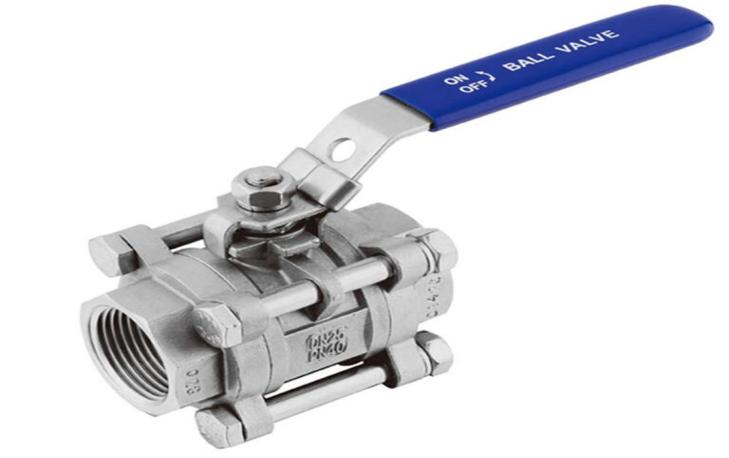
What's a 1-piece ball valve?
The 1-piece ball valve and flange gate valves are the same types. The difference is that its closing member is a ball, and it is through the ball around the center line of the valve body for rotation to achieve an open and close valve. The ball valve is primarily used for the cut-off, distribution and change of the flow direction of the medium of the pipeline. The one-piece ball valve is a new type of valve widely used.

What's a 2-piece ball valve?
The 2-piece ball valve‘s body casting adopts advanced technology and has a reasonable structure and beautiful shape. The valve seat features a resilient sealing structure. It seals reliably and opens and closes easily. The valve stem adopts a down-fitted structure with an inverted seal. When an abnormal pressure rises in the valve cavity, the valve stem will not be flushed out. The 2-piece split structure design can be used in various pipelines with PN1.0 to 12.5MPa and working temperatures -29 to 180℃ (the seal is reinforced PTFE) or -29 to 300℃ (the seal is para-polyphenylene). It can cut off or connect the medium in the pipeline, such as water, steam, oil, nitric acid, acetic acid, etc.

What's a 3-piece ball valve?
The 3-piece ball valve has many features such as compact structure, exquisite appearance, intelligent control, excellent quality, and ease to use. The three-piece ball valve is a manually operated rotary class ball valve with a 90° turning angle. It has excellent sealing performance, large flow capacity, small flow resistance coefficient, simple structure, simple maintenance, and long service life. The 3-piece ball valve is often used in applications with strict sealing requirements. In addition, we can widely use it to control gases, liquids, steam, and other media.

What are the differences between 1-piece ball valves, 2-piece ball valves, and 3-piece ball valves?
1. Working Principle
1)1-piece ball valve
- In the closed position, the ball is pressed against the seat by the mechanical pressure of the stem.
- When the handwheel is turned counterclockwise, the stem moves in the opposite direction. And the angular plane at its base causes the ball to disengage from the seat.
- The stem continues to lift and interacts with the guide pin in the spiral groove of the stem, which causes the ball to start rotating frictionlessly.
- Until it reaches the fully open position, the stem is lifted to the limit, and the ball rotates to the fully open position.
- When closed, turn the handle clockwise, at which point the stem starts to descend and causes the ball to leave the seat and rotate.
- Continuing to turn the handwheel, the stem is actuated by the guide pin embedded in the spiral groove on it, causing the stem and ball to rotate 90° simultaneously.
- The ball has rotated 90° without contact with the seat when it is about to close.
- During the last few turns of the handwheel, the angular plane at the bottom of the stem mechanically wedges against the ball. It presses it tightly against the seat, achieving a complete seal.
2)2-piece ball valve
The working principle of the 1-piece ball valve is to rotate the valve to make the valve open or closed. The ball valve is light to open and close and is small in size. We can make it into a large diameter. It has a reliable seal, a simple structure, and easy maintenance. Its sealing and spherical surface are often in a closed state, which is not easily eroded by the medium. Therefore it is widely used in various industries.
3)3-piece ball valve
The 3-piece ball valve closes tightly with only 90 degrees of rotation and little turning torque. The perfectly equal inner cavity of the valve body provides low resistance, the straight flow path for the medium. While we generally consider ball valves to be most suitable for direct opening and closing, we have also developed ball valves so that they can be designed for throttling and flow control.
The 3-piece ball valve is a relatively new type of ball valve. Its structure has some unique advantages, such as frictionless opening and closing, the seal is not easy to wear, and opening and closing torque are small. It reduces the size of the actuator used. It is equipped with a multi-turn electric actuator, and it can achieve the regulation and tight cut-off of the medium. We can widely use it in petroleum, chemical industry, urban water supply, drainage, etc., which require strict cut-off conditions.
2. Structure
1)1-piece ball valve
The 1-piece ball valve is manual. It has an integral structural design, all stabilized by a stopper to hold the ball in place. It allows for ease of access during maintenance. And the ball valve also has a smaller bore, where the ball is put in from one side of the valve body, and the seat has to be screwed in and pressed against the ball. Some non-standard one-piece ball valves have a temporary structure, so the best way to distinguish them is in the construction of the valve body. The one-piece ball valve is held in place by a plug that holds the ball in place. It is easy and practical to maintain and is often used for small-size valves.
2)2-piece ball valve
The 2-piece ball valve comprises two bolted bodies on the left and right. When fixed, it consists of 2 pieces of the valve body to clamp the ball valve. It is relatively difficult to maintain, and the most critical is to see how tight the middle screw is, which is directly related to whether the seal is tight. In addition, it is mainly used for atmospheric pressure and high-pressure environment, like non-standard class nominal diameter in DN50 below also belongs to the two-piece valve.
3)3-piece ball valve
The 3-piece ball valve is similar to the two-piece ball valve, but you can use the 3-piece type in ultra-high pressure environments. And the valve will have a structural design with three pieces of the valve body, held in place by the left and right side with necked flanges. It is normally available in nominal diameters of DN50 and above. However, it is commonly used for larger diameters and more essential occasions.
3. Pressure
The 3-piece ball valve has a much higher pressure resistance than the one-piece and two-piece ball valves. Four bolts secure three-piece ball valves on the outside, which provide an excellent tightening effect. It can pressurize the precision cast body to 1000 psi ≈ 6.9 MPa. If higher pressures are required, it should use a forged body.
What are the advantages of a ball valve?
BCST manual ball valve is suitable for various pipelines with working temperatures -29~180℃ (the sealing ring is reinforced PTFE) or -29~300℃ (the sealing ring is para-polyphenylene). We can use it to cut off or connect the medium in the pipeline, and it is widely used in various industries such as petroleum, chemical, metallurgy, electric power, etc.
Its characteristics are as follows.
1.It has a small fluid resistance, and its coefficient of resistance is equal to that of a pipe section of the same length.
2.It features a simple structure, compact size and light weight.
3.It is tight and reliable. The sealing surface material of the current ball valve is widely used plastic. Its sealing is good and has been commonly used in vacuum systems.
4.It is easy to operate and opens and closes quickly from fully open to fully closed as long as the rotation of 90 °, which facilitates the control of long distances.
5.It is easy to maintain. The ball valve structure is simple, and the seal is generally movable. Therefore, disassembly and replacement are relatively easy.
6.In fully open or fully closed, the ball and seat sealing surface is isolated from the medium. The medium through will not cause the valve sealing surface erosion.
7.It has a wide range of applications. The passage diameter from minor to a few millimeters, large to several meters, and high vacuum to high pressure can be applied. When the ball is rotated by 90 degrees, all the spherical surfaces should be present at the inlet and outlet, thus cutting off the flow.
What are the structural features of the ball valve?
1.Frictionless opening and closing. This feature completely solves the problem of traditional valves affecting sealing due to friction between sealing surfaces.
2.Top-mounted structure. The valve mounted on the pipeline can be directly inspected and maintained online, effectively reducing the installation stop and cost.
3.Single seat design. It eliminates the abnormal pressure rise of the medium in the valve cavity, which affects the safety of use.
4.Low torque design. The unique structural design of the valve stem only needs to match a small handle valve that can easily open and close.
5.Wedge seal structure. The valve is sealed by the mechanical force provided by the stem, which presses the ball wedge against the valve seat. It makes the sealing of the valve not affected by changes in the differential pressure of the pipeline, and the sealing performance is reliably guaranteed under various working conditions.
6.Self-cleaning structure of the sealing surface. When the ball is tilted away from the valve seat, the fluid in the pipeline passes evenly along the ball sealing surface at 360°. It not only eliminates the scouring of the high-speed fluid on the valve seat but also flushes away the accumulation on the sealing surface, achieving the purpose of self-cleaning.






